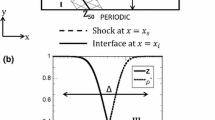Abstract
In core-collapse supernovae, strong blast waves drive interfaces susceptible to Rayleigh–Taylor (RT), Richtmyer–Meshkov (RM), and Kelvin–Helmholtz (KH) instabilities. In addition, perturbation growth can result from material expansion in large-scale velocity gradients behind the shock front. Laser-driven experiments are designed to produce a strongly shocked interface whose evolution is a scaled version of the unstable hydrogen–helium interface in core-collapse supernovae such as SN 1987A. The ultimate goal of this research is to develop an understanding of the effect of hydrodynamic instabilities and the resulting transition to turbulence on supernovae observables that remain as yet unexplained.
This paper represents a summary of recent results from a computational study of unstable systems driven by high Mach number shock and blast waves. For planar multimode systems, compressibility effects preclude the emergence of a regime of self-similar instability growth independent of the initial conditions (ICs) by allowing for memory of the initial conditions to be retained in the mix-width at all times. With higher-dimensional blast waves, divergence restores the properties necessary for establishment of the self-similar state, but achieving it requires very high initial characteristic mode number and high Mach number for the incident blast wave. Initial conditions predicted by some recent stellar calculations are incompatible with self-similarity.
Similar content being viewed by others
References
Chevalier, R.: 1976, ApJ 207, 872.
Dimonte, G., Youngs, D. L., Dimits, A., Weber, S., Marinak, M., et al.: 2002, Phys. Fluids 16(5), 1668.
Drake, R.P., Robey, H.F., Hurricane, O.A., Zhang, Y., Remington, B.A. et al.: 2002, AJ 564, 896.
Falk, S.W. and Arnett, W.D.: 1973, ApJ Lett. 180, L65.
Glimm, J. and Li, X.L.: 1988, Phys. Fluids 31(8), 2077.
Howell, L.H. and Greenough, J.A.: 2003, J. Comput. Phys. 184, 53.
Hughes, J.P., Rakowski, C.E., Burrows, D.N. and Slane, P.O.: 2000, ApJ 528, L109.
Kifonidis, K., Plewa, T., Janka, H.-Th. and Muller, E.: 2003, A&A 408, 621.
Meakin, C.A. and Arnett, W.D.: in preparation.
Meshkov, E.E.: 1969, Izv. AN SSSR Mekhanika Zhidkosti I Gaza 4(5), 151.
Miles, A.R.: “Bubble merger model for the nonlinear Rayleigh–Taylor instability driven by a strong blast wave”, to appear in Phys. Plasmas.
Oron, D., Arazi, L., Kartoon, D., Rikanati, A., Alon, U. and Shvarts, D.: 2001, Phys. Plasmas 8(6), 2883.
Rayleigh, J.W.S.: 1899, Scientific Papers, Cambridge University press, Cambridge.
Richtmyer, R.D.: 1960, Commun. Pure Appl. Math. 13, 297.
Sharp, K.I.: 1984, Physica D 12, 3.
Taylor, G.I.: 1950, Proc. R. Soc. Lond. Ser. A 201, 192.
Tueller, J., Barthelmy, S., Gehrels, N., Teegarden, B.J., Leventhal, M. and MacCallum, C.J.: 1990, ApJ 351, L41.
Wang, L., Baade, D., Höflich, P., Khokhlov, A., Wheeler, J.C. et al.: 2003, ApJ 591, 1110.
Youngs, D.L.: 1984, Physica D 12, 32.
Youngs, D.L.: 1994, Laser Part. Beams 12(4), 725.
Author information
Authors and Affiliations
Rights and permissions
About this article
Cite this article
Miles, A.R., Edwards, M.J. & Greenough, J.A. Effects of Initial Conditions on Compressible Mixing in Supernova-Relevant Laboratory Experiments. Astrophys Space Sci 298, 17–24 (2005). https://doi.org/10.1007/s10509-005-3907-3
Received:
Accepted:
Issue Date:
DOI: https://doi.org/10.1007/s10509-005-3907-3




